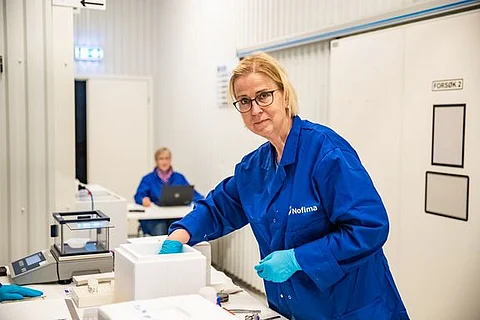Ingrid Lein has been responsible for the experiments in which Nofima studies kidney stones in rainbow trout.
Terje Aamodt Nofima
High CO₂ levels linked to kidney stones in farmed fish, research says
The Norwegian food research institute Nofima has found indications of a correlation between higher concentrations of carbon dioxide (CO₂) in the water during the juvenile stage of fish and their ability to develop kidney stones (also known as nephrocalcinosis).
There is always some carbon dioxide in the water in a tank with farmed fish, and it is necessary to keep it low to avoid harming the fish and preventing them from developing nephrocalcinosis, a rapidly growing kidney disease in farmed salmonids.
"It is uncertain how painful nephrocalcinosis is, and when it becomes severe. The fish may look perfectly healthy on the outside, but have destroyed kidneys," says veterinarian Kirsti Hjelde from Nofima, who has contributed to the development of X-ray diagnostics.
Additionally, Ingrid Lein from Nofima assured that "the extent and severity of kidney stones increase steadily as CO₂ concentration rises." Although she also suspects that it may not be the only cause of this disease.
Experiments and the use of X-Rays to study kidney stones in farmed fish
The results of this research have been made possible by the adoption of the method from the Centre for Research-based Innovation 'CtrlAQUA'. Years later, Nofima conducted experiments at the research station in Sunndalsøra, Norway.
"We now have a model system where we can induce nephrocalcinosis in rainbow trout and measure the effect on the fish. With this setup, it becomes easier to investigate other risk factors, interactions, and measures against kidney stones in farmed fish," explained André Meriac at Nofima.
Finally, the Norwegian entity has used X-rays on live fish on a large scale. In this way, it was possible to avoid killing these species after taking tissue samples.
"With X-rays, we avoid harming the fish. In this experiment, we took live X-rays of all individuals before they were transferred to sea and will take new X-rays at the end of the experiment to understand how the different treatments during the juvenile stage have affected how the fish coped in the sea," concluded Hjelde.


